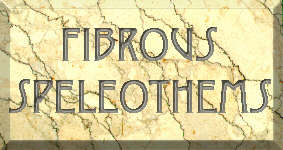
|
These formations are composed of aggregates of crystals which are fibrous or filament-like in nature. Most typically they are gypsum, but can be composed of a variety of other mineral salts like epsomite or halite. In form they are generally classified into four subtypes: hair, cotton, rope, and snow. The latter type results from a disintegration of any of the first three types.
The lefthand photo shows a classic gypsum rope formation, from a cave in the Grand Canyon. The righthand photo shows a more cotton-like example from a cave in Tennessee. In the middel is an unusual coiled form of gypsum from a cave in New Zealand known as the Spring.
All fibrous formations form from saturated solutions being squeezed out of pores in the bedrock (usually limestone) and depositing as they hit air. They grow from the base, with pressure forcing the deposited sections out as new sections are formed. The size of the pores determines how thick the crystals are, finer pores forming cotton or hair and larger ones forming rope. This is a similar mechanism to that which forms the more rigid forms known as gypsum flowers. |
![]()
 |
 |
 |
![]()
| Back to: | |
 |
Created: December, 1998 Author: Dave Bunnell |